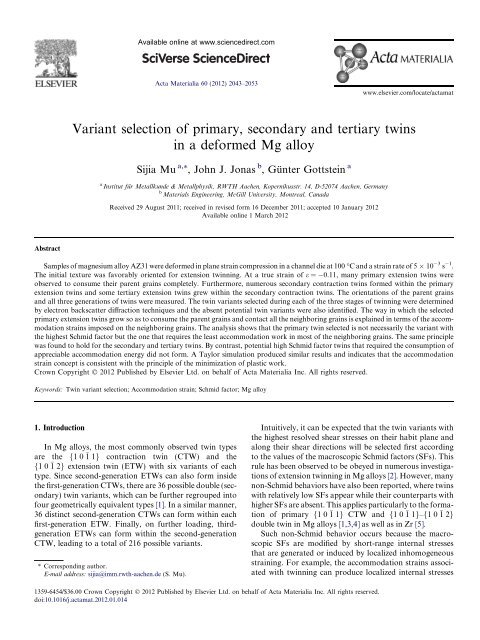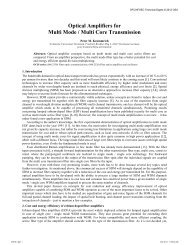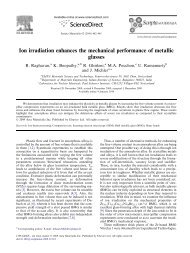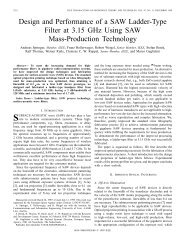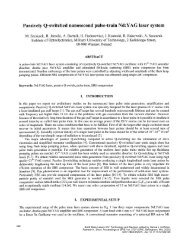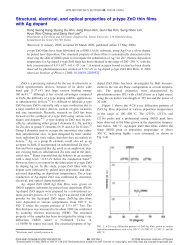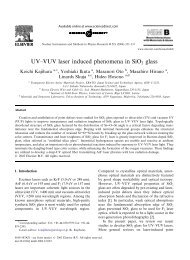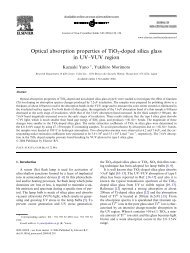Variant selection of primary, secondary and tertiary twins in a ...
Variant selection of primary, secondary and tertiary twins in a ...
Variant selection of primary, secondary and tertiary twins in a ...
Create successful ePaper yourself
Turn your PDF publications into a flip-book with our unique Google optimized e-Paper software.
Available onl<strong>in</strong>e at www.sciencedirect.com<br />
Acta Materialia 60 (2012) 2043–2053<br />
www.elsevier.com/locate/actamat<br />
<strong>Variant</strong> <strong>selection</strong> <strong>of</strong> <strong>primary</strong>, <strong>secondary</strong> <strong>and</strong> <strong>tertiary</strong> <strong>tw<strong>in</strong>s</strong><br />
<strong>in</strong> a deformed Mg alloy<br />
Sijia Mu a,⇑ , John J. Jonas b ,Günter Gottste<strong>in</strong> a<br />
a Institut für Metallkunde & Metallphysik, RWTH Aachen, Kopernikusstr. 14, D-52074 Aachen, Germany<br />
b Materials Eng<strong>in</strong>eer<strong>in</strong>g, McGill University, Montreal, Canada<br />
Received 29 August 2011; received <strong>in</strong> revised form 16 December 2011; accepted 10 January 2012<br />
Available onl<strong>in</strong>e 1 March 2012<br />
Abstract<br />
Samples <strong>of</strong> magnesium alloy AZ31 were deformed <strong>in</strong> plane stra<strong>in</strong> compression <strong>in</strong> a channel die at 100 °C <strong>and</strong> a stra<strong>in</strong> rate <strong>of</strong> 5 10 3 s 1 .<br />
The <strong>in</strong>itial texture was favorably oriented for extension tw<strong>in</strong>n<strong>in</strong>g. At a true stra<strong>in</strong> <strong>of</strong> e = 0.11, many <strong>primary</strong> extension <strong>tw<strong>in</strong>s</strong> were<br />
observed to consume their parent gra<strong>in</strong>s completely. Furthermore, numerous <strong>secondary</strong> contraction <strong>tw<strong>in</strong>s</strong> formed with<strong>in</strong> the <strong>primary</strong><br />
extension <strong>tw<strong>in</strong>s</strong> <strong>and</strong> some <strong>tertiary</strong> extension <strong>tw<strong>in</strong>s</strong> grew with<strong>in</strong> the <strong>secondary</strong> contraction <strong>tw<strong>in</strong>s</strong>. The orientations <strong>of</strong> the parent gra<strong>in</strong>s<br />
<strong>and</strong> all three generations <strong>of</strong> <strong>tw<strong>in</strong>s</strong> were measured. The tw<strong>in</strong> variants selected dur<strong>in</strong>g each <strong>of</strong> the three stages <strong>of</strong> tw<strong>in</strong>n<strong>in</strong>g were determ<strong>in</strong>ed<br />
by electron backscatter diffraction techniques <strong>and</strong> the absent potential tw<strong>in</strong> variants were also identified. The way <strong>in</strong> which the selected<br />
<strong>primary</strong> extension <strong>tw<strong>in</strong>s</strong> grow so as to consume the parent gra<strong>in</strong>s <strong>and</strong> contact all the neighbor<strong>in</strong>g gra<strong>in</strong>s is expla<strong>in</strong>ed <strong>in</strong> terms <strong>of</strong> the accommodation<br />
stra<strong>in</strong>s imposed on the neighbor<strong>in</strong>g gra<strong>in</strong>s. The analysis shows that the <strong>primary</strong> tw<strong>in</strong> selected is not necessarily the variant with<br />
the highest Schmid factor but the one that requires the least accommodation work <strong>in</strong> most <strong>of</strong> the neighbor<strong>in</strong>g gra<strong>in</strong>s. The same pr<strong>in</strong>ciple<br />
was found to hold for the <strong>secondary</strong> <strong>and</strong> <strong>tertiary</strong> <strong>tw<strong>in</strong>s</strong>. By contrast, potential high Schmid factor <strong>tw<strong>in</strong>s</strong> that required the consumption <strong>of</strong><br />
appreciable accommodation energy did not form. A Taylor simulation produced similar results <strong>and</strong> <strong>in</strong>dicates that the accommodation<br />
stra<strong>in</strong> concept is consistent with the pr<strong>in</strong>ciple <strong>of</strong> the m<strong>in</strong>imization <strong>of</strong> plastic work.<br />
Crown Copyright Ó 2012 Published by Elsevier Ltd. on behalf <strong>of</strong> Acta Materialia Inc. All rights reserved.<br />
Keywords: Tw<strong>in</strong> variant <strong>selection</strong>; Accommodation stra<strong>in</strong>; Schmid factor; Mg alloy<br />
1. Introduction<br />
In Mg alloys, the most commonly observed tw<strong>in</strong> types<br />
are the f1 0 11g contraction tw<strong>in</strong> (CTW) <strong>and</strong> the<br />
f1 0 12g extension tw<strong>in</strong> (ETW) with six variants <strong>of</strong> each<br />
type. S<strong>in</strong>ce second-generation ETWs can also form <strong>in</strong>side<br />
the first-generation CTWs, there are 36 possible double (<strong>secondary</strong>)<br />
tw<strong>in</strong> variants, which can be further regrouped <strong>in</strong>to<br />
four geometrically equivalent types [1]. In a similar manner,<br />
36 dist<strong>in</strong>ct second-generation CTWs can form with<strong>in</strong> each<br />
first-generation ETW. F<strong>in</strong>ally, on further load<strong>in</strong>g, thirdgeneration<br />
ETWs can form with<strong>in</strong> the second-generation<br />
CTW, lead<strong>in</strong>g to a total <strong>of</strong> 216 possible variants.<br />
⇑ Correspond<strong>in</strong>g author.<br />
E-mail address: sijia@imm.rwth-aachen.de (S. Mu).<br />
Intuitively, it can be expected that the tw<strong>in</strong> variants with<br />
the highest resolved shear stresses on their habit plane <strong>and</strong><br />
along their shear directions will be selected first accord<strong>in</strong>g<br />
to the values <strong>of</strong> the macroscopic Schmid factors (SFs). This<br />
rule has been observed to be obeyed <strong>in</strong> numerous <strong>in</strong>vestigations<br />
<strong>of</strong> extension tw<strong>in</strong>n<strong>in</strong>g <strong>in</strong> Mg alloys [2]. However, many<br />
non-Schmid behaviors have also been reported, where <strong>tw<strong>in</strong>s</strong><br />
with relatively low SFs appear while their counterparts with<br />
higher SFs are absent. This applies particularly to the formation<br />
<strong>of</strong> <strong>primary</strong> f1 0 11g CTW <strong>and</strong> f1 0 11g–f1 0 12g<br />
double tw<strong>in</strong> <strong>in</strong> Mg alloys [1,3,4] as well as <strong>in</strong> Zr [5].<br />
Such non-Schmid behavior occurs because the macroscopic<br />
SFs are modified by short-range <strong>in</strong>ternal stresses<br />
that are generated or <strong>in</strong>duced by localized <strong>in</strong>homogeneous<br />
stra<strong>in</strong><strong>in</strong>g. For example, the accommodation stra<strong>in</strong>s associated<br />
with tw<strong>in</strong>n<strong>in</strong>g can produce localized <strong>in</strong>ternal stresses<br />
1359-6454/$36.00 Crown Copyright Ó 2012 Published by Elsevier Ltd. on behalf <strong>of</strong> Acta Materialia Inc. All rights reserved.<br />
doi:10.1016/j.actamat.2012.01.014
2044 S. Mu et al. / Acta Materialia 60 (2012) 2043–2053<br />
that neutralize or <strong>of</strong>fset the macroscopic stress <strong>and</strong> <strong>in</strong> this<br />
way prevent potential <strong>tw<strong>in</strong>s</strong> with high macroscopic SFs<br />
from form<strong>in</strong>g. Conversely, when accommodation is easy<br />
[1,4], the <strong>in</strong>duced <strong>in</strong>ternal stresses are small <strong>and</strong> even low<br />
macroscopic SFs are sufficient to produce <strong>tw<strong>in</strong>s</strong>. These<br />
concepts have been employed <strong>in</strong> crystal level models to<br />
account for variant <strong>selection</strong> dur<strong>in</strong>g tw<strong>in</strong>n<strong>in</strong>g. Therefore,<br />
while detailed quantitative underst<strong>and</strong><strong>in</strong>g is still lack<strong>in</strong>g,<br />
<strong>in</strong> part because <strong>of</strong> the <strong>in</strong>homogeneous nature <strong>of</strong> the localized<br />
stra<strong>in</strong> fields, it has been possible to model some <strong>of</strong><br />
the effects <strong>of</strong> these fields [6–8].<br />
The accommodation stra<strong>in</strong>s <strong>in</strong>duced by tw<strong>in</strong>n<strong>in</strong>g are<br />
generally relaxed by slip or tw<strong>in</strong>n<strong>in</strong>g <strong>in</strong> the adjo<strong>in</strong><strong>in</strong>g gra<strong>in</strong><br />
[9,10]. These stra<strong>in</strong>s can be evaluated by rotat<strong>in</strong>g the tw<strong>in</strong>n<strong>in</strong>g<br />
shear displacement gradient tensor <strong>in</strong>to the crystallographic<br />
frame <strong>of</strong> the neighbor<strong>in</strong>g gra<strong>in</strong>. The analysis <strong>of</strong> this<br />
phenomenon <strong>in</strong>volves three sets <strong>of</strong> reference frames: (i) the<br />
tw<strong>in</strong>n<strong>in</strong>g system frame; (ii) the crystallographic frame <strong>of</strong><br />
the matrix; <strong>and</strong> (iii) the crystallographic frame <strong>of</strong> the neighbor<strong>in</strong>g<br />
gra<strong>in</strong>. Details <strong>of</strong> the manipulations required are<br />
described <strong>in</strong> Ref. [4].<br />
Each <strong>of</strong> the accommodation stra<strong>in</strong> tensor components e ij<br />
(where i is the shear direction <strong>and</strong> j is the shear plane) can <strong>in</strong><br />
turn be given a physical <strong>in</strong>terpretation <strong>in</strong> terms <strong>of</strong> the dislocation<br />
or tw<strong>in</strong>n<strong>in</strong>g mechanism <strong>in</strong>volved: (i) the e zx <strong>and</strong> e zy<br />
components correspond to accommodation by means <strong>of</strong><br />
tw<strong>in</strong>n<strong>in</strong>g or pyramidal hc + ai slip (here y is parallel to<br />
one <strong>of</strong> the basal glide Burgers vectors, i.e. to the ½1 1 20Š<br />
direction; z is perpendicular to the basal plane; <strong>and</strong> x is<br />
mutually perpendicular to both, follow<strong>in</strong>g the right-h<strong>and</strong><br />
rule); (ii) the e yz <strong>and</strong> e xz shears can be respectively accommodated<br />
by s<strong>in</strong>gle or double basal glide; (iii) the e yx correspond<br />
to s<strong>in</strong>gle prismatic glide <strong>and</strong> the e xy correspond to<br />
balanced glide on the two rema<strong>in</strong><strong>in</strong>g prism planes. (Note<br />
that the present reference frame differs slightly from that<br />
employed <strong>in</strong> Ref. [4], <strong>in</strong> that it has been rotated by 90° about<br />
the z-axis.)<br />
Among the five possible deformation modes (three slip<br />
<strong>and</strong> two tw<strong>in</strong>n<strong>in</strong>g), basal slip <strong>and</strong> extension tw<strong>in</strong>n<strong>in</strong>g can<br />
be activated with relative ease due to their low associated<br />
critical resolved shear stresses. As a result, the magnitude<br />
<strong>of</strong> the <strong>in</strong>duced back or <strong>in</strong>ternal stress is small <strong>and</strong> there is<br />
little modification <strong>of</strong> the macroscopic SF. By contrast, prismatic<br />
slip has a critical resolved shear stress (CRSS) at least<br />
an order <strong>of</strong> magnitude higher than those <strong>of</strong> basal slip <strong>and</strong><br />
extension tw<strong>in</strong>n<strong>in</strong>g at ambient temperatures [11]. Moreover,<br />
no alternative mechanism is available to provide the<br />
deformation components (e xy <strong>and</strong> e yx ) produced by prismatic<br />
slip. In this case, very large localized back-stresses will<br />
be developed, which will tend to oppose the macroscopic<br />
SF. Therefore, when a potential tw<strong>in</strong> variant requires a<br />
large amount <strong>of</strong> prismatic glide <strong>in</strong> the neighbor<strong>in</strong>g gra<strong>in</strong>,<br />
the nucleation <strong>of</strong> this variant will be rather difficult even if<br />
the nom<strong>in</strong>al SF is relatively high [4].<br />
The large differences <strong>in</strong> the energy required to accommodate<br />
the various potential tw<strong>in</strong> variants have been employed<br />
to expla<strong>in</strong> non-Schmid variant <strong>selection</strong> dur<strong>in</strong>g <strong>secondary</strong><br />
extension [1] <strong>and</strong> <strong>primary</strong> contraction [4] tw<strong>in</strong>n<strong>in</strong>g <strong>in</strong> Mg<br />
alloys AZ31 <strong>and</strong> AM30. In the current work, we extend this<br />
type <strong>of</strong> variant <strong>selection</strong> analysis to the nucleation <strong>and</strong><br />
growth <strong>of</strong> <strong>primary</strong> ETWs <strong>in</strong> Mg alloys as well as to that<br />
<strong>of</strong> the two generations <strong>of</strong> <strong>tw<strong>in</strong>s</strong> that follow. That is, we test<br />
the accommodation stra<strong>in</strong> hypothesis on three further types<br />
<strong>of</strong> <strong>tw<strong>in</strong>s</strong> <strong>in</strong> addition to those <strong>of</strong> Refs. [1,4]. We therefore<br />
consider further the relative importance <strong>of</strong> the macroscopic<br />
Schmid factor on the one h<strong>and</strong> <strong>and</strong> the accommodation<br />
stra<strong>in</strong> (<strong>and</strong> <strong>in</strong>duced <strong>in</strong>ternal stress) on the other.<br />
In the current <strong>in</strong>vestigation, samples <strong>of</strong> Mg alloy AZ31<br />
were deformed <strong>in</strong> plane stra<strong>in</strong> compression (PSC) to stra<strong>in</strong>s<br />
<strong>in</strong> the range between 0.02 <strong>and</strong> 0.2 at 100 °C. Most <strong>of</strong><br />
the gra<strong>in</strong>s were <strong>in</strong>itially favorably oriented for extension<br />
tw<strong>in</strong>n<strong>in</strong>g. Copious ETWs were formed on load<strong>in</strong>g <strong>and</strong> progressively<br />
replaced the start<strong>in</strong>g microstructure by the time a<br />
stra<strong>in</strong> <strong>of</strong> 0.08 was atta<strong>in</strong>ed. As deformation was extended<br />
beyond 0.08, many <strong>secondary</strong> CTWs formed with<strong>in</strong> the <strong>primary</strong><br />
ETWs. At a stra<strong>in</strong> <strong>of</strong> about 0.10, some <strong>tertiary</strong><br />
ETWs were generated <strong>in</strong>side the <strong>secondary</strong> CTWs. F<strong>in</strong>ally,<br />
when stra<strong>in</strong>s beyond 0.13 were applied, the CTWs were<br />
almost completely replaced by the <strong>tertiary</strong> <strong>tw<strong>in</strong>s</strong>. The orientations<br />
<strong>of</strong> all three generations <strong>of</strong> <strong>tw<strong>in</strong>s</strong> were determ<strong>in</strong>ed<br />
by electron backscatter diffraction (EBSD) techniques.<br />
In what follows, the results obta<strong>in</strong>ed at a stra<strong>in</strong> <strong>of</strong> 0.11<br />
are exam<strong>in</strong>ed <strong>in</strong> detail. This stra<strong>in</strong> was chosen because all<br />
three generations <strong>of</strong> <strong>tw<strong>in</strong>s</strong> could be readily dist<strong>in</strong>guished.<br />
The orientations <strong>and</strong> SFs <strong>of</strong> both the observed <strong>tw<strong>in</strong>s</strong> as<br />
well as all potential tw<strong>in</strong> variants were calculated. Both<br />
the values <strong>of</strong> the macroscopic Schmid factors <strong>and</strong> the<br />
accommodation stra<strong>in</strong> hypothesis were then employed to<br />
account for the variant <strong>selection</strong> observed dur<strong>in</strong>g the nucleation<br />
<strong>and</strong> growth <strong>of</strong> the three generations <strong>of</strong> <strong>tw<strong>in</strong>s</strong>. In order<br />
to calculate the accommodation stra<strong>in</strong>s that the tw<strong>in</strong> variants<br />
were try<strong>in</strong>g to impose on their neighbor<strong>in</strong>g gra<strong>in</strong>s, the<br />
orientations <strong>of</strong> all adjacent gra<strong>in</strong>s were also measured.<br />
Here, only the neighbors observed <strong>in</strong> the 2-D sections were<br />
considered <strong>and</strong> the neighbors located above <strong>and</strong> below the<br />
plane <strong>of</strong> section were not taken <strong>in</strong>to account. Nevertheless,<br />
new methods, both destructive <strong>and</strong> non-destructive, for<br />
measur<strong>in</strong>g aspects <strong>of</strong> 3-D microstructures <strong>in</strong> bulk polycrystals<br />
are becom<strong>in</strong>g more common. Some <strong>of</strong> these methods<br />
allow for more direct measurement <strong>of</strong> aspects <strong>of</strong> tw<strong>in</strong> formation<br />
[12,13].<br />
2. Experimental<br />
The as-received material was the commercial wrought<br />
Mg alloy AZ31B (3.33 wt.% Al <strong>and</strong> 1 wt.% Zn) <strong>in</strong> the<br />
as-cast condition. The <strong>in</strong>got was first rolled at 400 °C for<br />
several passes up to 50% thickness reduction. It was then<br />
annealed at 400 °C for 12 h to produce an appropriate<br />
microstructure <strong>and</strong> the desired <strong>in</strong>itial texture. The result<strong>in</strong>g<br />
material was fully recrystallized with an average gra<strong>in</strong> size<br />
<strong>of</strong> about 25 lm, free <strong>of</strong> mechanical <strong>tw<strong>in</strong>s</strong>. The texture after<br />
anneal<strong>in</strong>g was measured by conventional X-ray techniques.<br />
The (0002) pole figure (PF) exhibited a well-def<strong>in</strong>ed basal
S. Mu et al. / Acta Materialia 60 (2012) 2043–2053 2045<br />
texture. Details <strong>of</strong> the microstructure <strong>and</strong> texture were presented<br />
<strong>in</strong> an earlier paper [14].<br />
PSC was carried out us<strong>in</strong>g channel die equipment. The<br />
specimens were characterized by their longitud<strong>in</strong>al (LD),<br />
transverse (TD) <strong>and</strong> compression (CD) directions, as<br />
shown <strong>in</strong> Fig. 1a. The material was compressed along<br />
CD <strong>and</strong> elongated along LD, whereas broaden<strong>in</strong>g along<br />
TD was entirely suppressed. The PSC specimens <strong>of</strong> dimensions<br />
12 10 6mm 3 were fabricated from the rolled<br />
sheet by electrodischarge mach<strong>in</strong><strong>in</strong>g, with their TD–CD<br />
planes parallel to the roll<strong>in</strong>g plane. The <strong>in</strong>itial texture measured<br />
on the plane perpendicular to CD is represented <strong>in</strong><br />
terms <strong>of</strong> its (0002) PF <strong>in</strong> Fig. 1b. As can be seen, most<br />
<strong>of</strong> the gra<strong>in</strong>s had their c-axes aligned with LD with a<br />
spread <strong>of</strong> about 30° about TD <strong>and</strong> CD. Dur<strong>in</strong>g PSC, most<br />
<strong>of</strong> the gra<strong>in</strong>s underwent c-axis extension, which promoted<br />
the formation <strong>of</strong> f1 0 12g ETWs. In the current work,<br />
the specimens were tested at 100 °C at a constant stra<strong>in</strong><br />
rate <strong>of</strong> 10 3 s 1 .<br />
The evolution <strong>of</strong> the flow stress was monitored up to a<br />
stra<strong>in</strong> <strong>of</strong> 0.2, as shown <strong>in</strong> Fig. 1c. The unusual sigmoidal<br />
flow behavior can be subdivided <strong>in</strong>to three regimes. The<br />
deformation mechanisms operat<strong>in</strong>g dur<strong>in</strong>g the different<br />
stages <strong>of</strong> deformation have been described <strong>in</strong> earlier publications<br />
[14,15] as follows: <strong>in</strong> stage (I), dislocation slip is<br />
accompanied by the nucleation <strong>of</strong> f1 0 12g ETWs, lead<strong>in</strong>g<br />
to a decreas<strong>in</strong>g stra<strong>in</strong> harden<strong>in</strong>g rate; <strong>in</strong> stage (II), the rapid<br />
<strong>in</strong>crease <strong>in</strong> harden<strong>in</strong>g rate is associated with massive<br />
f1 0 12g ETW growth; <strong>in</strong> stage (III), conventional parabolic<br />
harden<strong>in</strong>g is displayed, with the concurrent occurrence<br />
<strong>of</strong> some f1 0 11g contraction tw<strong>in</strong>n<strong>in</strong>g. In the current work,<br />
<strong>in</strong> order to produce the three generations <strong>of</strong> <strong>tw<strong>in</strong>s</strong>, the tests<br />
were carried out to compressive true stra<strong>in</strong>s <strong>of</strong> 0.11; this<br />
corresponds to stage III, as <strong>in</strong>dicated on the flow curve <strong>in</strong><br />
Fig. 1c.<br />
Prior to compression, the PSC specimens were heated to<br />
100 °C <strong>and</strong> equilibrated for 15 m<strong>in</strong>. Boron nitride powder<br />
was employed as a lubricant to m<strong>in</strong>imize friction between<br />
the specimens <strong>and</strong> the die. After PSC, the specimens were<br />
immediately unloaded <strong>and</strong> quenched <strong>in</strong> water to stabilize<br />
the microstructure. The EBSD microtextures <strong>and</strong> X-ray<br />
macrotextures were measured <strong>in</strong> the centers <strong>of</strong> the surfaces<br />
perpendicular to CD. The EBSD specimens were ground<br />
us<strong>in</strong>g SiC paper <strong>and</strong> then mechanically polished us<strong>in</strong>g 3<br />
<strong>and</strong> 1 lm diamond paste. An alcohol-based lubricant was<br />
employed to m<strong>in</strong>imize surface oxidation. No electropolish<strong>in</strong>g<br />
was applied. The EBSD measurements were performed<br />
us<strong>in</strong>g a LEO Gem<strong>in</strong>i 1530 high-resolution field emission<br />
gun scann<strong>in</strong>g electron microscope <strong>of</strong> with a LaB 6 filament<br />
<strong>and</strong> a step size <strong>of</strong> about 0.5 lm. This microscope is equipped<br />
with an EBSD system with HKL Channel 5 s<strong>of</strong>tware. The<br />
result<strong>in</strong>g EBSD <strong>in</strong>dex<strong>in</strong>g <strong>of</strong> the current specimens at e =<br />
0.11 was 92.7%.<br />
3. Results<br />
3.1. Microstructure, texture <strong>and</strong> disorientation distribution<br />
at e = 0.11<br />
Fig. 1. (a) Schematic illustration <strong>of</strong> the channel die specimen coord<strong>in</strong>ate<br />
system identify<strong>in</strong>g the longitud<strong>in</strong>al (LD), transverse (TD) <strong>and</strong> compression<br />
(CD) directions; (b) <strong>in</strong>itial texture <strong>of</strong> a channel die specimen measured<br />
on the plane perpendicular to the compression direction (CD); (c) the flow<br />
curve <strong>of</strong> a specimen deformed at 100 °C at a stra<strong>in</strong> rate <strong>of</strong> 10 3 s 1 . Three<br />
regimes can be seen: (I) the elastic–plastic transition followed by a<br />
decreas<strong>in</strong>g stra<strong>in</strong>-harden<strong>in</strong>g rate; (II) a stage <strong>of</strong> rapidly <strong>in</strong>creas<strong>in</strong>g<br />
harden<strong>in</strong>g rate; (III) conventional parabolic harden<strong>in</strong>g behavior with a<br />
decreas<strong>in</strong>g stra<strong>in</strong>-harden<strong>in</strong>g rate.<br />
An EBSD orientation map obta<strong>in</strong>ed at e = 0.11 is<br />
shown <strong>in</strong> Fig. 2a. Boundaries with disorientations >5°<br />
are marked <strong>in</strong> black, <strong>and</strong> regions separated by high-angle<br />
boundaries are identified by colors related to their orientations<br />
(as specified by their Euler angles). Two k<strong>in</strong>ds <strong>of</strong> tw<strong>in</strong><br />
structures were detected: (i) those with a th<strong>in</strong> <strong>and</strong> elongated<br />
lenticular appearance (CTWs), <strong>and</strong> (ii) those <strong>of</strong> irregular<br />
shape <strong>and</strong> <strong>of</strong> a size comparable to the gra<strong>in</strong> size (ETWs).<br />
The latter were difficult to dist<strong>in</strong>guish from matrix gra<strong>in</strong>s.<br />
Inside many tw<strong>in</strong>ned gra<strong>in</strong>s, more than one set <strong>of</strong> <strong>tw<strong>in</strong>s</strong><br />
<strong>of</strong> different orientations (different colors) were detected. It<br />
was also observed that many <strong>tw<strong>in</strong>s</strong> did not propagate completely<br />
across the matrix gra<strong>in</strong>, but term<strong>in</strong>ated with<strong>in</strong> the<br />
gra<strong>in</strong> or were divided <strong>in</strong>to sections by the matrix or other<br />
<strong>tw<strong>in</strong>s</strong>. The characteristic disorientation angles <strong>and</strong> rotation<br />
axes <strong>of</strong> the most frequently observed tw<strong>in</strong> types <strong>in</strong> Mg<br />
alloys are listed <strong>in</strong> Fig. 2b. The <strong>tw<strong>in</strong>s</strong> characterized <strong>in</strong> this<br />
way <strong>in</strong> the EBSD images are identified us<strong>in</strong>g different colors,<br />
as shown <strong>in</strong> Fig. 2a <strong>and</strong>e.<br />
The boundary disorientation distribution is illustrated <strong>in</strong><br />
Fig. 2c as a function <strong>of</strong> disorientation angle. The correspond<strong>in</strong>g<br />
rotation axes are presented <strong>in</strong> the form <strong>of</strong> <strong>in</strong>verse<br />
PFs. The most frequently detected boundaries are those<br />
with disorientations <strong>of</strong> 80–90° about the h 12 10i axis<br />
<strong>and</strong> 50–65° about the h0 1 10i axis. Accord<strong>in</strong>g to Fig. 2b,
2046 S. Mu et al. / Acta Materialia 60 (2012) 2043–2053<br />
Fig. 2. (a) EBSD map measured at a stra<strong>in</strong> <strong>of</strong> e = 0.11 (the gra<strong>in</strong> outl<strong>in</strong>ed <strong>in</strong> red is <strong>of</strong> <strong>in</strong>terest)—the regions separated by high-angle boundaries are<br />
identified by colors related to their orientations (Euler angles); (b) the most frequently observed tw<strong>in</strong> types <strong>in</strong> Mg alloys are listed together with the<br />
correspond<strong>in</strong>g disorientations with respect to the matrix given <strong>in</strong> m<strong>in</strong>imum angle-axis pairs; (c) disorientation distribution; (d) (0002) PF for the<br />
e = 0.11 sample; (e) the Euler angle color code.<br />
these are boundaries between: (i) ETWs <strong>and</strong> the matrix<br />
(ETW–MAT with a characteristic disorientation <strong>of</strong> 86°<br />
h 12 10i), <strong>and</strong> (ii) two ETWs <strong>of</strong> different types (ETW–<br />
ETW with a characteristic disorientation <strong>of</strong> 60 h10 10i),<br />
respectively. The high frequency <strong>of</strong> ETW–MAT <strong>and</strong><br />
ETW–ETW boundaries <strong>in</strong>dicates that there was massive<br />
activation <strong>and</strong> growth <strong>of</strong> <strong>primary</strong> ETWs up to the stra<strong>in</strong> level<br />
employed.<br />
The formation <strong>of</strong> such ETW–ETW boundaries can be<br />
understood as follows. Although a gra<strong>in</strong> can theoretically<br />
tw<strong>in</strong> on any <strong>of</strong> the six f1 0 12g planes, those <strong>tw<strong>in</strong>s</strong> can<br />
be assumed to nucleate where the resolved shear stress on<br />
the tw<strong>in</strong>n<strong>in</strong>g plane <strong>and</strong> <strong>in</strong> the shear direction exceeds the<br />
critical value s c . When two or three ETW variants form<br />
<strong>in</strong> a particular matrix gra<strong>in</strong>, one tw<strong>in</strong> will generally nucleate<br />
first, after which the second (<strong>and</strong> third) ETWs nucleate<br />
at slightly larger stra<strong>in</strong>s <strong>and</strong> applied stresses. Accord<strong>in</strong>g to<br />
this view, the ETWs grow <strong>in</strong>to the matrix cont<strong>in</strong>uously<br />
until stra<strong>in</strong><strong>in</strong>g ceases or their boundaries collide with the<br />
other <strong>tw<strong>in</strong>s</strong> or the gra<strong>in</strong> boundary.<br />
Another slight peak <strong>in</strong> the disorientation distribution<br />
appears at 30–45° about the h 12 10i rotation axis. These<br />
disorientations can be classified as boundaries between the<br />
matrix <strong>and</strong> f1 0 11g–f1 0 12g double <strong>tw<strong>in</strong>s</strong>. This set <strong>of</strong><br />
frequently detected boundaries <strong>in</strong>dicates that a second generation<br />
<strong>of</strong> CTWs formed with<strong>in</strong> the first-generation ETWs.<br />
As most gra<strong>in</strong>s <strong>in</strong>itially had their c-axes aligned with LD,<br />
the conditions were not favorable for the formation <strong>of</strong><br />
first-generation CTWs. Once ETWs formed <strong>and</strong> reoriented<br />
the tw<strong>in</strong>ned part <strong>of</strong> a gra<strong>in</strong> by rotat<strong>in</strong>g the c-axis about the<br />
h 12 10i by 86°, align<strong>in</strong>g it with CD, contraction tw<strong>in</strong>n<strong>in</strong>g<br />
could take place dur<strong>in</strong>g further compression. In this way,<br />
the first generation ETWs became the “matrix” for the secondgeneration<br />
CTWs. Meanwhile, a still smaller peak with<br />
much lower frequency appears <strong>in</strong> the range 50–65° about<br />
the h 12 10i axis, which corresponds to f1 0 11g CTWs.<br />
To differentiate among the three generations <strong>of</strong> <strong>tw<strong>in</strong>s</strong>, they<br />
are labeled here as <strong>primary</strong> ETWs, <strong>secondary</strong> CTWs, <strong>and</strong><br />
<strong>tertiary</strong> ETWs.<br />
The macrotexture measured on the surface perpendicular<br />
to CD at e = 0.11 is presented <strong>in</strong> the form <strong>of</strong> a (0002) PF<br />
<strong>in</strong> Fig. 2d. On comparison with the <strong>in</strong>itial texture shown <strong>in</strong><br />
Fig. 1b, it can be seen that the orig<strong>in</strong>al LD texture component<br />
(c-axes parallel to LD) has disappeared <strong>and</strong> been<br />
replaced with three texture components: the newly generated<br />
CD basal component (c-axes parallel to CD with an
S. Mu et al. / Acta Materialia 60 (2012) 2043–2053 2047<br />
<strong>in</strong>tensity peak <strong>in</strong> the center <strong>of</strong> the (0002) PF), <strong>and</strong> the two<br />
m<strong>in</strong>or texture components located symmetrically between<br />
LD <strong>and</strong> CD. The newly formed CD texture component<br />
can be attributed to f1 0 12g extension tw<strong>in</strong>n<strong>in</strong>g, which<br />
rotates the crystal by 86°. The two texture components<br />
between LD <strong>and</strong> CD can be produced either by dislocation<br />
slip, which rotates the LD orientation toward CD gradually,<br />
or by contraction tw<strong>in</strong>n<strong>in</strong>g, which rotates the newly<br />
formed CD orientation back towards LD aga<strong>in</strong> by rotat<strong>in</strong>g<br />
the c-axis about the h 12 10i axis by 56°.<br />
In order to <strong>in</strong>vestigate the formation <strong>of</strong> these three generations<br />
<strong>of</strong> <strong>tw<strong>in</strong>s</strong> <strong>and</strong> to determ<strong>in</strong>e a possible criterion for<br />
the variant <strong>selection</strong>s observed, a gra<strong>in</strong> <strong>in</strong> which all three<br />
k<strong>in</strong>ds <strong>of</strong> <strong>tw<strong>in</strong>s</strong> were detected by the EBSD technique was<br />
chosen for further <strong>in</strong>vestigation, as identified by the red<br />
ellipse <strong>in</strong> Fig. 2a. One further matter should be mentioned.<br />
There is a low-angle (2°) boundary with<strong>in</strong> the selected<br />
gra<strong>in</strong>. S<strong>in</strong>ce the two parts with<strong>in</strong> the gra<strong>in</strong> are <strong>of</strong> similar<br />
orientation, they will be considered to belong to the same<br />
matrix gra<strong>in</strong> <strong>and</strong> the low-angle boundary to have formed<br />
by the operation <strong>of</strong> slightly different sets <strong>of</strong> slip systems<br />
<strong>in</strong> the two parts <strong>of</strong> the gra<strong>in</strong>.<br />
3.2. Identification <strong>of</strong> the three generations <strong>of</strong> <strong>tw<strong>in</strong>s</strong><br />
The selected gra<strong>in</strong> is shown at higher magnification <strong>in</strong><br />
Fig. 3a. The different regions separated by boundaries with<br />
>10° disorientations (between <strong>tw<strong>in</strong>s</strong> <strong>and</strong> matrix) are identified<br />
with the same colors accord<strong>in</strong>g to their orientations<br />
(Fig. 2e) as before <strong>and</strong> are now denoted by letters from a<br />
to h. Their orientations are listed <strong>in</strong> Euler angle form <strong>in</strong><br />
Table 1 <strong>and</strong> shown schematically <strong>in</strong> Fig. 3b on a (0002)<br />
Table 1<br />
Euler angles <strong>of</strong> all the detected orientations<br />
<strong>in</strong> the “red” gra<strong>in</strong> outl<strong>in</strong>ed <strong>in</strong><br />
Fig. 2a. (The (0°,0°,0°) orientation has<br />
one <strong>of</strong> its ½11 20Š directions parallel to<br />
the y-axis <strong>and</strong> the basal plane is<br />
perpendicular to the z-axis.)<br />
a 98844.7<br />
b 1662711<br />
c 1711384.7<br />
d 1701557<br />
e 106630.2<br />
f 52.513947<br />
g 1498322<br />
h 11316655<br />
PF. All the <strong>in</strong>ternal high-angle boundaries are black <strong>and</strong><br />
numbered from 1 to 10. The correspond<strong>in</strong>g disorientation<br />
angles <strong>and</strong> rotation axes are listed <strong>in</strong> Table 2. The orientations<br />
<strong>of</strong> all the adjacent neighbor<strong>in</strong>g gra<strong>in</strong>s (identified us<strong>in</strong>g<br />
roman numerals from I to XI) are listed <strong>in</strong> Table 3. In what<br />
follows, the order <strong>of</strong> the various tw<strong>in</strong> generations is<br />
deduced by analyz<strong>in</strong>g the orientation relationships, i.e.<br />
the disorientations, between pairs <strong>of</strong> adjacent orientations<br />
with<strong>in</strong> the selected “red” gra<strong>in</strong>. Then the orientations <strong>and</strong><br />
SFs <strong>of</strong> all six potential tw<strong>in</strong> variants perta<strong>in</strong><strong>in</strong>g to each generation<br />
were calculated. These are represented <strong>in</strong> Fig. 4a–e<br />
<strong>in</strong> terms <strong>of</strong> (0002) <strong>and</strong> f1 1 20g PFs, which will now be<br />
employed to identify the tw<strong>in</strong> variants that were actually<br />
selected.<br />
As listed <strong>in</strong> Table 2, boundary 2 separat<strong>in</strong>g regions a<br />
<strong>and</strong> b exhibits a disorientation <strong>of</strong> 76° about the h1 210i<br />
axis. Accord<strong>in</strong>g to Fig. 2b, the closest disorientation is that<br />
Fig. 3. (a) EBSD map <strong>of</strong> the gra<strong>in</strong> outl<strong>in</strong>ed <strong>in</strong> Fig. 2a that conta<strong>in</strong>s <strong>tertiary</strong> <strong>tw<strong>in</strong>s</strong>: the matrix <strong>and</strong> <strong>tw<strong>in</strong>s</strong> are denoted by letters from a to h, the tw<strong>in</strong><br />
boundaries by numbers from 1 to 10, the neighbor<strong>in</strong>g gra<strong>in</strong>s by roman numerals from I to XI, <strong>and</strong> the matrices <strong>and</strong> <strong>tw<strong>in</strong>s</strong> <strong>in</strong> certa<strong>in</strong> neighbor<strong>in</strong>g gra<strong>in</strong>s are<br />
denoted by M <strong>and</strong> T, respectively; (b) the orientations <strong>of</strong> the matrix <strong>and</strong> the <strong>tw<strong>in</strong>s</strong> are illustrated on (0002) stereographic projections.
2048 S. Mu et al. / Acta Materialia 60 (2012) 2043–2053<br />
Table 2<br />
Disorientation angles <strong>and</strong> rotation axes <strong>of</strong> the boundaries <strong>in</strong>side<br />
the “red” gra<strong>in</strong>.<br />
1 66 h1 210i<br />
2 76 h1 210i f10 12g ETW<br />
3 57 h 1010i ð10 12Þ–ð01 12Þ<br />
4 4 h 12 10i ð10 12Þ–ð 1012Þ<br />
5 54 h 2110i f10 11g CTW<br />
6 39 h1 210i f10 11g–f1 0 12g<br />
7 56 h 2110i f10 11g CTW<br />
8 38 h1 210i f10 11g–f1 0 12g<br />
9 38 h 12 10i f10 11g–f1 0 12g<br />
10 88 h 12 10i f10 12g ETW<br />
Table 3<br />
Orientations (<strong>in</strong> Euler angles) <strong>of</strong> the gra<strong>in</strong>s adjacent to the “red”<br />
gra<strong>in</strong>. (In some gra<strong>in</strong>s, two orientations with a tw<strong>in</strong> relationship<br />
were detected; these are listed <strong>in</strong> the second column. The<br />
(0°,0°,0°) orientation has one <strong>of</strong> its ½11 20Š directions parallel<br />
to the y-axis <strong>and</strong> the basal plane is perpendicular to the z-axis).<br />
I 87696 3215330<br />
II 13210548 102458<br />
III 1009056 81471<br />
IV 787847 14416234<br />
V 12017014<br />
VI 667018 2716452<br />
VII 667221 15116536<br />
VIII 14116635<br />
IX 14813054<br />
X 777338 1061637<br />
XI 92762 2915031<br />
<strong>of</strong> an ETW boundary with a characteristic disorientation <strong>of</strong><br />
86° about the h1 210i axis. Although one could expect<br />
that the much larger b region is the matrix <strong>and</strong> that region<br />
a is the tw<strong>in</strong>, the (0002) PF shows that the c-axis <strong>of</strong> a is<br />
close to LD, as are those <strong>of</strong> most <strong>of</strong> the gra<strong>in</strong>s <strong>in</strong> the <strong>in</strong>itial<br />
texture. Conversely, the (0002) pole <strong>of</strong> region b is about<br />
90° away from LD <strong>and</strong> close to CD. Thus region b cannot<br />
be the matrix for the ETWs <strong>and</strong> region a, despite its very<br />
small area, was the matrix for <strong>primary</strong> ETW b.<br />
Microstructurally, regions c <strong>and</strong> d appear to be two<br />
<strong>tw<strong>in</strong>s</strong> formed with<strong>in</strong> <strong>primary</strong> ETW b. However, boundaries<br />
3 <strong>and</strong> 4 between b–c <strong>and</strong> b–d, respectively, exhibit disorientations<br />
<strong>of</strong> 57 h 1010i <strong>and</strong> 4 h 12 10i. These are ETW–<br />
ETW boundaries accord<strong>in</strong>g to Fig. 2b. Therefore, regions<br />
c <strong>and</strong> d are <strong>in</strong> fact two further <strong>primary</strong> ETWs formed <strong>in</strong>side<br />
the a matrix. Dur<strong>in</strong>g growth, these three <strong>tw<strong>in</strong>s</strong> consumed<br />
the matrix gra<strong>in</strong> almost completely. In order to characterize<br />
variants b, c <strong>and</strong> d, the orientations <strong>and</strong> SFs <strong>of</strong> all six<br />
potential ð1 0 12Þ ETW variants (see Table 4) <strong>of</strong> gra<strong>in</strong> a<br />
(denoted as at1–at6) were calculated. These are represented<br />
on the (0002) PF <strong>in</strong> Fig. 4a. As shown <strong>in</strong> this Fig. 4a, at6<br />
has its (0002) pole close to that <strong>of</strong> c, while tw<strong>in</strong> variants<br />
at5 <strong>and</strong> at2 have their (0002) poles close to both b <strong>and</strong><br />
d. Not<strong>in</strong>g that the Schmid factors for at2, at5 <strong>and</strong> at6 are<br />
0.404, 0.392 <strong>and</strong> 0.323, respectively, <strong>and</strong> that ETW b<br />
spread <strong>and</strong> consumed its parent gra<strong>in</strong> almost completely,<br />
here we conclude that region b corresponds to variant at2<br />
with the highest SF (0.404). In this way, the rema<strong>in</strong><strong>in</strong>g<br />
first-generation variants c <strong>and</strong> d were identified as correspond<strong>in</strong>g<br />
to at6 <strong>and</strong> at5, respectively. All the calculations<br />
<strong>of</strong> <strong>secondary</strong> <strong>and</strong> <strong>tertiary</strong> <strong>tw<strong>in</strong>s</strong> that follow were based on<br />
this type <strong>of</strong> reason<strong>in</strong>g, the validity <strong>of</strong> which will be established<br />
later.<br />
Boundaries 5 (between b <strong>and</strong> e) <strong>and</strong> 7 (between b <strong>and</strong> g)<br />
exhibit disorientations <strong>of</strong> 54° <strong>and</strong> 56° around the h 2110i<br />
axis, respectively, which <strong>in</strong>dicate that e <strong>and</strong> g are secondgeneration<br />
f1 0 11g CTWs. The orientations <strong>and</strong> SFs <strong>of</strong><br />
the six possible CTW variants (see Table 4) <strong>of</strong> orientation<br />
b (denoted as bc1 tobc6) were calculated <strong>and</strong> are represented<br />
<strong>in</strong> Fig. 4b on the (0002) PF. As can be seen, <strong>secondary</strong><br />
CTWs e <strong>and</strong> g correspond to CTW variants bc5 <strong>and</strong><br />
bc6, respectively. Although the SFs for these two variants<br />
are relatively high, namely 0.315 <strong>and</strong> 0.464 for bc5 (e)<br />
<strong>and</strong> bc6(g), respectively, it is important to note that variant<br />
bc1 with the highest SF (0.473) did not appear.<br />
Boundaries 6 (between b <strong>and</strong> f) <strong>and</strong> 8 (between b <strong>and</strong> h)<br />
exhibit the same disorientation <strong>of</strong> 38 h1 210i, which<br />
reveals that f <strong>and</strong> h are double <strong>tw<strong>in</strong>s</strong> (ETWs <strong>in</strong>side CTWs)<br />
that formed with<strong>in</strong> a “matrix” consist<strong>in</strong>g <strong>of</strong> <strong>primary</strong> ETW<br />
b. This is because boundaries 6 <strong>and</strong> 8 were measured with<br />
respect to region b <strong>and</strong> not the orig<strong>in</strong>al matrix a. Thus they<br />
are classified as <strong>tertiary</strong> <strong>tw<strong>in</strong>s</strong> <strong>in</strong> this work. S<strong>in</strong>ce the lamellae<br />
<strong>of</strong> <strong>tertiary</strong> <strong>tw<strong>in</strong>s</strong> f <strong>and</strong> h are parallel to <strong>secondary</strong> CTWs<br />
e <strong>and</strong> g, respectively, e <strong>and</strong> g were concluded to be the<br />
matrices for <strong>tertiary</strong> <strong>tw<strong>in</strong>s</strong> f <strong>and</strong> h, respectively. The orientations<br />
<strong>and</strong> SFs <strong>of</strong> all the possible ETW variants (Table 4)<br />
<strong>of</strong> e <strong>and</strong> g were calculated (denoted as et1–et6 <strong>and</strong> gt1–gt6,<br />
respectively). They are illustrated on their (0002) PFs <strong>in</strong><br />
Fig. 4c <strong>and</strong> d, respectively. In this way, <strong>tertiary</strong> tw<strong>in</strong> f<br />
was identified as possibly correspond<strong>in</strong>g to tw<strong>in</strong> variants<br />
et2 oret5 <strong>and</strong> h to gt3 orgt6.<br />
These ambiguities were resolved as follows. Accord<strong>in</strong>g<br />
to Ref. [1], only four types <strong>of</strong> double tw<strong>in</strong> boundaries<br />
(regrouped from the 36 possible tw<strong>in</strong> variant comb<strong>in</strong>ations)<br />
can occur or be observed experimentally. If the<br />
ETW variant selected for the f regions was et2, the correspond<strong>in</strong>g<br />
double tw<strong>in</strong> boundary between bc5 <strong>and</strong> et2, i.e.<br />
ð0 111Þ–ð0 1 12Þ, should exhibit a disorientation <strong>of</strong><br />
30:1 h2 1 10i. This is <strong>in</strong>consistent with the measured disorientation<br />
<strong>of</strong> 38 h1 210i for boundary 6. On the other<br />
h<strong>and</strong>, the <strong>selection</strong> <strong>of</strong> et5 results <strong>in</strong> a ð0 111Þ–ð0 112Þ<br />
double tw<strong>in</strong> boundary disorientation (i.e. between bc5<br />
<strong>and</strong> et5) <strong>of</strong> 37:5 h2 1 10i, which agrees with the observation.<br />
Similarly, while the <strong>selection</strong> <strong>of</strong> gt3 for the <strong>tertiary</strong><br />
ETW h results <strong>in</strong> a ð1 101Þ–ð 1102Þ boundary with a<br />
disorientation <strong>of</strong> 30:1 h11 20i, the <strong>selection</strong> <strong>of</strong> gt6 leads<br />
to a ð1 101Þ–ð1 102Þ boundary disorientation <strong>of</strong> 37:5 <br />
h1 1 20i, which is close to the measured one for boundary<br />
8 between b <strong>and</strong> h (38 h1 210i). It is important to note<br />
that, dur<strong>in</strong>g the <strong>tertiary</strong> tw<strong>in</strong>n<strong>in</strong>g that took place with<strong>in</strong><br />
<strong>secondary</strong> CTW e, the variant (et1) with the highest SF<br />
(0.146) did not appear, whereas the variant (et5 orf) with<br />
a fairly low SF (0.091) was the one that formed.<br />
In summary, the variant <strong>selection</strong>s tak<strong>in</strong>g place dur<strong>in</strong>g<br />
three generations <strong>of</strong> tw<strong>in</strong>n<strong>in</strong>g were identified by EBSD
S. Mu et al. / Acta Materialia 60 (2012) 2043–2053 2049<br />
Fig. 4. The orientations <strong>and</strong> correspond<strong>in</strong>g Schmid factors <strong>of</strong> the three generations <strong>of</strong> tw<strong>in</strong> variants illustrated on (0002) stereographic projections: (a)<br />
at1–at6, (b) bc1–bc6, (c) et1–et6, (d) gt1–gt6; (e) description <strong>of</strong> the variant <strong>selection</strong>s occurr<strong>in</strong>g dur<strong>in</strong>g the three generations <strong>of</strong> tw<strong>in</strong>n<strong>in</strong>g.<br />
Table 4<br />
Miller <strong>in</strong>dices <strong>of</strong> the six extension tw<strong>in</strong> (ETW) (t1–t6) <strong>and</strong> six contraction<br />
tw<strong>in</strong> (CTW) (c1–c6) variants formed dur<strong>in</strong>g: (i) <strong>primary</strong> <strong>and</strong> <strong>tertiary</strong><br />
extension tw<strong>in</strong>n<strong>in</strong>g; <strong>and</strong> (ii) <strong>secondary</strong> contraction tw<strong>in</strong>n<strong>in</strong>g, respectively.<br />
ETW<br />
CTW<br />
t1 f1 0 12gh 1011i c1 f10 11gh10 1 2i<br />
t2 f0 1 12gh0 111i c2 f01 11gh01 1 2i<br />
t3 f 1102gh1 101i c3 f 1101gh 110 2i<br />
t4 f 1012gh1 0 11i c4 f 1011gh 101 2i<br />
t5 f0 112gh0 1 11i c5 f0 111gh0 11 2i<br />
t6 f1 102gh 1101i c6 f1 101gh1 10 2i<br />
analysis <strong>and</strong> the orientations <strong>of</strong> the various potential tw<strong>in</strong><br />
variants calculated. The analysis <strong>in</strong>dicates that the variants<br />
selected dur<strong>in</strong>g <strong>primary</strong> extension tw<strong>in</strong>n<strong>in</strong>g were at2, at5<br />
<strong>and</strong> at6 for orientations b, d <strong>and</strong> c, respectively. Dur<strong>in</strong>g <strong>secondary</strong><br />
contraction tw<strong>in</strong>n<strong>in</strong>g, bc5 <strong>and</strong> bc6 were the tw<strong>in</strong><br />
variants that corresponded to orientations e <strong>and</strong> g, respectively.<br />
Meanwhile, dur<strong>in</strong>g <strong>tertiary</strong> extension tw<strong>in</strong>n<strong>in</strong>g, the<br />
variants selected were et5 <strong>and</strong> gt6 for f <strong>and</strong> h, respectively.<br />
4. Discussion<br />
4.1. Summary <strong>of</strong> the essential experimental results<br />
The detailed microstructural analysis <strong>of</strong> the deformed<br />
Mg polycrystal revealed that deformation tw<strong>in</strong>n<strong>in</strong>g up to<br />
the third order was activated dur<strong>in</strong>g deformation. However,<br />
not all potential tw<strong>in</strong> variants were observed. Rather,<br />
for each tw<strong>in</strong> generation, specific tw<strong>in</strong> variants were<br />
strongly favored. A detailed shear stress analysis revealed<br />
that the selected <strong>tw<strong>in</strong>s</strong> were not necessarily the ones with<br />
the highest SFs. Therefore, <strong>in</strong> what follows, the factors<br />
controll<strong>in</strong>g tw<strong>in</strong> nucleation <strong>and</strong> growth <strong>in</strong> Mg alloys will<br />
be exam<strong>in</strong>ed <strong>in</strong> more detail.
2050 S. Mu et al. / Acta Materialia 60 (2012) 2043–2053<br />
4.2. Does the accommodation stra<strong>in</strong> control the growth <strong>of</strong> the<br />
<strong>primary</strong> extension <strong>tw<strong>in</strong>s</strong>?<br />
Dur<strong>in</strong>g <strong>primary</strong> extension tw<strong>in</strong>n<strong>in</strong>g, three different variants<br />
were nucleated <strong>and</strong> grew. The orientations <strong>and</strong> SFs <strong>of</strong><br />
all the possible ETW variants <strong>of</strong> matrix a were calculated.<br />
We deduced that the tw<strong>in</strong> variants correspond<strong>in</strong>g to<br />
observed orientations b, d <strong>and</strong> c were at2, at5 <strong>and</strong> at6,<br />
respectively. The SFs <strong>of</strong> the selected variants were all relatively<br />
high, especially for at2 (b) <strong>and</strong> at5 (d) with SFs <strong>of</strong><br />
0.404 <strong>and</strong> 0.392, respectively. However, variant b grew to<br />
a considerably greater extent than the other two. Thus<br />
although nucleation appeared to be <strong>in</strong>fluenced by the SF,<br />
the latter cannot properly account for the different growth<br />
capabilities displayed by <strong>tw<strong>in</strong>s</strong> <strong>of</strong> similar SF.<br />
In Mg alloys, once ETWs are nucleated, they grow cont<strong>in</strong>uously<br />
dur<strong>in</strong>g stra<strong>in</strong><strong>in</strong>g <strong>and</strong> gradually replace the<br />
matrix. In the present case, the tw<strong>in</strong> with the greatest ease<br />
<strong>of</strong> growth consumed its parent gra<strong>in</strong> almost completely <strong>and</strong><br />
thus essentially contacted all the adjacent gra<strong>in</strong>s. Once a<br />
tw<strong>in</strong> reaches a gra<strong>in</strong> boundary, the immediate region <strong>of</strong><br />
the adjo<strong>in</strong><strong>in</strong>g gra<strong>in</strong> is sheared <strong>and</strong> stress concentrations<br />
are accumulated at the boundary. These stress concentrations<br />
are relaxed by slip <strong>and</strong> tw<strong>in</strong>n<strong>in</strong>g <strong>in</strong> the neighbor<strong>in</strong>g<br />
gra<strong>in</strong>, produc<strong>in</strong>g what are known as the accommodation<br />
stra<strong>in</strong>s. By rotat<strong>in</strong>g the tw<strong>in</strong>n<strong>in</strong>g shear displacement gradient<br />
tensor from the tw<strong>in</strong> system frame <strong>in</strong>to the crystal<br />
frame <strong>of</strong> the neighbor<strong>in</strong>g gra<strong>in</strong>, the nature <strong>of</strong> the accommodation<br />
stra<strong>in</strong> that the ETW is try<strong>in</strong>g to impose on the<br />
neighbor<strong>in</strong>g gra<strong>in</strong> can be determ<strong>in</strong>ed. When the growth<br />
<strong>of</strong> a particular ETW variant requires the operation <strong>of</strong> a<br />
“difficult” deformation mechanism such as prismatic slip<br />
<strong>in</strong> the adjacent gra<strong>in</strong>, high back-stresses are generated<br />
<strong>and</strong> such growth is h<strong>in</strong>dered. S<strong>in</strong>ce the prismatic glide<br />
stra<strong>in</strong> components e xy <strong>and</strong> e yx are classified as “difficult”,<br />
<strong>in</strong> the follow<strong>in</strong>g, only these components will be considered<br />
to govern tw<strong>in</strong> variant <strong>selection</strong>.<br />
At e = 0.11, <strong>primary</strong> ETW b had already almost completely<br />
consumed its parent gra<strong>in</strong> <strong>and</strong> contacted most <strong>of</strong> the<br />
neighbor<strong>in</strong>g gra<strong>in</strong>s. The accommodation stra<strong>in</strong> tensors <strong>of</strong><br />
all six matrix a tw<strong>in</strong> variants <strong>in</strong> all the adjacent gra<strong>in</strong>s were<br />
therefore calculated. However, s<strong>in</strong>ce the growth competition<br />
only concerned the three selected ETWs at2, at5 <strong>and</strong><br />
at6, only the values for these are plotted <strong>in</strong> Fig. 5. Ase xy<br />
is one <strong>of</strong> the “difficult” stra<strong>in</strong> components, <strong>in</strong> Fig. 5, the values<br />
<strong>of</strong> e xy /e xy (m<strong>in</strong>) are plotted for neighbor<strong>in</strong>g gra<strong>in</strong>s I–XI<br />
(Fig. 5a), where e xy (m<strong>in</strong>) is the lowest e xy imposed by one<br />
<strong>of</strong> the six tw<strong>in</strong> variants on the neighbor<strong>in</strong>g gra<strong>in</strong> be<strong>in</strong>g<br />
considered.<br />
For ease <strong>of</strong> comparison, the data <strong>of</strong> Fig. 5a are<br />
regrouped <strong>and</strong> replotted <strong>in</strong> Fig. 5b, where the values are<br />
collected for each <strong>of</strong> the variants. 1 It is clear that variant<br />
1 In some <strong>of</strong> the neighbor<strong>in</strong>g gra<strong>in</strong>s, two orientations obey<strong>in</strong>g an ETW<br />
relationship were detected. Both orientations were considered as adjacent<br />
gra<strong>in</strong>s, although only the lower value <strong>of</strong> e xy was used for plott<strong>in</strong>g<br />
purposes.<br />
Fig. 5. (a) Accommodation stra<strong>in</strong>s e xy /e xy (m<strong>in</strong>) that three <strong>of</strong> the <strong>primary</strong><br />
extension <strong>tw<strong>in</strong>s</strong> (at2, at5 <strong>and</strong> at6) are try<strong>in</strong>g to impose on neighbor<strong>in</strong>g<br />
gra<strong>in</strong>s I–IX; (b) the values <strong>of</strong> e xy /e xy (m<strong>in</strong>) are collected for each <strong>of</strong> the tw<strong>in</strong><br />
variants (at2, at5 <strong>and</strong> at6). Here e xy (m<strong>in</strong>) is the smallest e xy be<strong>in</strong>g imposed<br />
by one <strong>of</strong> the six variants on the adjacent gra<strong>in</strong>.<br />
at2 (b) requires the lowest e xy <strong>in</strong> all the neighbor<strong>in</strong>g gra<strong>in</strong>s<br />
(except for IX), whereas variants at5 (d) <strong>and</strong> at6 (c) require<br />
much larger amounts <strong>of</strong> the “difficult” e xy stra<strong>in</strong> (as much<br />
as 10–100 times more, which is not evident due to the curtailment<br />
<strong>of</strong> the y-axis). Tw<strong>in</strong> variant at6, which corresponds<br />
to tw<strong>in</strong> orientation c, displays relatively low e xy /<br />
e xy (m<strong>in</strong>) values with respect to its adjo<strong>in</strong><strong>in</strong>g gra<strong>in</strong>s, i.e.<br />
gra<strong>in</strong>s VI–IX, as shown <strong>in</strong> Fig. 5b. By contrast, tw<strong>in</strong> variant<br />
at5 (d), which had a higher SF (0.392) than at6 (0.323),<br />
nevertheless did not grow, an observation that can be readily<br />
expla<strong>in</strong>ed by its relatively high values <strong>of</strong> e xy <strong>in</strong> most <strong>of</strong><br />
the neighbor<strong>in</strong>g gra<strong>in</strong>s (see the second set <strong>of</strong> columns <strong>in</strong><br />
Fig. 5b). The values <strong>of</strong> e xy + e yx were also calculated for<br />
the three variants. These led to similar conclusions <strong>and</strong><br />
are not presented here.<br />
4.3. Does the accommodation stra<strong>in</strong> control the nucleation <strong>of</strong><br />
the <strong>secondary</strong> contraction <strong>tw<strong>in</strong>s</strong>?<br />
In this section we test the validity <strong>of</strong> the accommodation<br />
stra<strong>in</strong> hypothesis by apply<strong>in</strong>g it to the <strong>selection</strong> <strong>of</strong> the <strong>secondary</strong><br />
CTW variants. As shown <strong>in</strong> the EBSD map <strong>of</strong><br />
Fig. 3a, two sets <strong>of</strong> <strong>secondary</strong> CTWs e <strong>and</strong> g, as well as<br />
two sets <strong>of</strong> <strong>tertiary</strong> ETWs f <strong>and</strong> h were detected. It was concluded<br />
above that CTWs e <strong>and</strong> g were the matrices for <strong>tertiary</strong><br />
<strong>tw<strong>in</strong>s</strong> f <strong>and</strong> h, respectively. Therefore, when we<br />
consider the gra<strong>in</strong>s adjacent to the <strong>secondary</strong> CTWs, the<br />
ones <strong>in</strong> contact with the <strong>tertiary</strong> <strong>tw<strong>in</strong>s</strong> should also be taken<br />
<strong>in</strong>to account (as these were formerly neighbor<strong>in</strong>g gra<strong>in</strong>s <strong>of</strong>
S. Mu et al. / Acta Materialia 60 (2012) 2043–2053 2051<br />
the <strong>secondary</strong> <strong>tw<strong>in</strong>s</strong>). S<strong>in</strong>ce the orig<strong>in</strong>al nucleation site <strong>of</strong><br />
<strong>secondary</strong> CTW e is not known, all three adjacent gra<strong>in</strong>s,<br />
namely gra<strong>in</strong>s II, III <strong>and</strong> IX, were considered. The accommodation<br />
stra<strong>in</strong>s that tw<strong>in</strong> e might have tried to impose on<br />
all three neighbor<strong>in</strong>g gra<strong>in</strong>s were therefore calculated.<br />
However, only the gra<strong>in</strong> that required the least e xy to permit<br />
the nucleation <strong>of</strong> tw<strong>in</strong> e was used for f<strong>in</strong>al plott<strong>in</strong>g. In<br />
the case <strong>of</strong> <strong>tertiary</strong> ETW h, one end is located at tw<strong>in</strong> f <strong>and</strong><br />
the other at the gra<strong>in</strong> IX boundary. Therefore, only the<br />
gra<strong>in</strong> IX boundary was considered a possible nucleation<br />
site for <strong>secondary</strong> CTW g.<br />
The accommodation stra<strong>in</strong> tensors that the six potential<br />
tw<strong>in</strong> variants bc1–bc6 might have tried to impose on gra<strong>in</strong>s<br />
II, III, IX <strong>and</strong> XI were calculated <strong>and</strong> the e xy /e xy (m<strong>in</strong>) values<br />
are plotted for the six tw<strong>in</strong> variants <strong>in</strong> Fig. 6. Here it<br />
can be seen that selected tw<strong>in</strong> variants bc5 (e) <strong>and</strong> bc6 (g)<br />
require the lowest values <strong>of</strong> e xy <strong>in</strong> neighbor<strong>in</strong>g gra<strong>in</strong>s III<br />
<strong>and</strong> IX, respectively. On the other h<strong>and</strong>, variant bc1 with<br />
the highest SF (0.473) was nevertheless not formed, as it<br />
required the highest values <strong>of</strong> e xy <strong>in</strong> all the neighbor<strong>in</strong>g<br />
gra<strong>in</strong>s. This confirms the observation <strong>in</strong> Ref. [4] that the<br />
CTW variant requir<strong>in</strong>g the lowest e xy accommodation<br />
stra<strong>in</strong> is the one that forms, as long as the SF is positive.<br />
4.4. Does the accommodation stra<strong>in</strong> control the nucleation <strong>of</strong><br />
the <strong>tertiary</strong> extension <strong>tw<strong>in</strong>s</strong>?<br />
In the EBSD map <strong>of</strong> Fig. 3a, two <strong>tertiary</strong> ETWs f <strong>and</strong> h<br />
were detected. It was concluded above that the correspond<strong>in</strong>g<br />
variants were et5 <strong>and</strong> gt6, respectively. As the <strong>tertiary</strong><br />
ETWs were formed with<strong>in</strong> <strong>secondary</strong> CTWs, the parent<br />
gra<strong>in</strong> b for <strong>secondary</strong> <strong>tw<strong>in</strong>s</strong> e <strong>and</strong> g was considered as the<br />
neighbor<strong>in</strong>g gra<strong>in</strong>. For the selected variants et5 <strong>and</strong> gt6,<br />
calculation showed that the required e xy accommodation<br />
stra<strong>in</strong>s <strong>in</strong> neighbor<strong>in</strong>g gra<strong>in</strong> b were not the lowest ones.<br />
Instead, it appeared that the sum <strong>of</strong> the required e xy + e yx<br />
stra<strong>in</strong>s was the decid<strong>in</strong>g factor. This is illustrated <strong>in</strong> Fig. 7a<br />
<strong>and</strong> b, where the sums are plotted for all six variants. It can<br />
be seen that the et5 (e) <strong>and</strong> gt6 (g) variants require the lowest<br />
total e xy + e yx accommodation stra<strong>in</strong>s. This <strong>in</strong>dicates<br />
that, s<strong>in</strong>ce both the e xy <strong>and</strong> e yx components <strong>in</strong>volve prismatic<br />
slip, it is physically more realistic to consider the<br />
sum <strong>of</strong> e xy + e yx as the appropriate measure <strong>of</strong> difficult<br />
accommodation. This approach expla<strong>in</strong>s why variant et1<br />
with the highest SF (0.146) was not formed, as it required<br />
the highest e xy + e yx accommodation stra<strong>in</strong>, as shown <strong>in</strong><br />
Fig. 7a.<br />
4.5. Physical <strong>in</strong>terpretation <strong>of</strong> the accommodation stra<strong>in</strong><br />
hypothesis us<strong>in</strong>g a Taylor model<br />
The underly<strong>in</strong>g assumption <strong>of</strong> the accommodation<br />
stra<strong>in</strong> hypothesis is that tw<strong>in</strong> variants that require highenergy<br />
shear to take place <strong>in</strong> adjacent gra<strong>in</strong>s will be disfavored.<br />
To evaluate this hypothesis, we conducted Taylor<br />
simulations to determ<strong>in</strong>e the variants that would impose<br />
the least accommodation work on their nearest neighbor<br />
gra<strong>in</strong>s.<br />
For the simulations, we considered the microstructural<br />
arrangement depicted <strong>in</strong> Fig. 3. Gra<strong>in</strong> b is a first-order tw<strong>in</strong><br />
Fig. 6. Accommodation stra<strong>in</strong>s that the six possible <strong>secondary</strong> contraction<br />
<strong>tw<strong>in</strong>s</strong> (bc1–bc6) were try<strong>in</strong>g to impose on selected neighbor<strong>in</strong>g gra<strong>in</strong>s.<br />
(a) Tw<strong>in</strong> e on either the IIIM (matrix) or IIIT (tw<strong>in</strong>) gra<strong>in</strong> boundary; (b)<br />
tw<strong>in</strong> g on the gra<strong>in</strong> IX boundary.<br />
Fig. 7. Schmid factors <strong>and</strong> total accommodation stra<strong>in</strong>s e xy + e yx that the<br />
<strong>tertiary</strong> extension tw<strong>in</strong> variants (a) et1–et6 <strong>and</strong> (b) gt1–gt6 were try<strong>in</strong>g to<br />
impose on neighbor<strong>in</strong>g gra<strong>in</strong> b.
2052 S. Mu et al. / Acta Materialia 60 (2012) 2043–2053<br />
<strong>of</strong> the matrix, which has been virtually completely replaced<br />
by the tw<strong>in</strong>. Two other first-order <strong>tw<strong>in</strong>s</strong>, gra<strong>in</strong>s c <strong>and</strong> d, were<br />
also formed, but occupy much smaller volumes than the<br />
dom<strong>in</strong>ant first-order tw<strong>in</strong> b. These first-order <strong>tw<strong>in</strong>s</strong> conta<strong>in</strong><br />
several second-order <strong>tw<strong>in</strong>s</strong>, such as gra<strong>in</strong>s e <strong>and</strong> g. Gra<strong>in</strong>s f<br />
<strong>and</strong> h are third-order <strong>tw<strong>in</strong>s</strong> that have essentially consumed<br />
their second-order tw<strong>in</strong> parents e <strong>and</strong> g, respectively.<br />
To <strong>in</strong>vestigate the <strong>selection</strong> <strong>of</strong> the first-order tw<strong>in</strong> variants,<br />
we performed full constra<strong>in</strong>t Taylor simulations on<br />
all 11 neighbor gra<strong>in</strong>s <strong>of</strong> gra<strong>in</strong> b. For this purpose, the<br />
shape change attributable to the first-order tw<strong>in</strong>n<strong>in</strong>g was<br />
imposed on each nearest neighbor gra<strong>in</strong> separately <strong>and</strong><br />
the slip (c) distributions on the activated systems were<br />
determ<strong>in</strong>ed. In this way, it was possible to establish which<br />
variant required the least expenditure <strong>of</strong> energy (Taylor<br />
energy) P n<br />
s¼1 s sc s , where n is the number <strong>of</strong> activated slip<br />
<strong>and</strong> tw<strong>in</strong>n<strong>in</strong>g systems <strong>and</strong> s the critical resolved shear stress<br />
<strong>of</strong> the respective system. This simulation was carried out<br />
for each <strong>of</strong> the six first-order tw<strong>in</strong> variants. For calculation<br />
<strong>of</strong> the Taylor energy, we assumed ratios <strong>of</strong> the critical<br />
resolved shear stresses s for basal, prismatic <strong>and</strong> pyramidal<br />
slip, as well as extension tw<strong>in</strong>n<strong>in</strong>g <strong>of</strong> 1:9:10:4 with respect<br />
to basal slip. This has been shown to yield good results<br />
<strong>in</strong> Mg deformation texture simulations [14].<br />
The results are presented <strong>in</strong> Fig. 8a <strong>in</strong> terms <strong>of</strong> the Taylor<br />
energies required for the formation <strong>of</strong> the three variants <strong>in</strong><br />
each neighbor<strong>in</strong>g gra<strong>in</strong>. The total Taylor energies summed<br />
over all 11 neighbor<strong>in</strong>g gra<strong>in</strong>s are illustrated <strong>in</strong> Fig. 8b.<br />
(The other three variants, which did not form <strong>in</strong> the microstructure,<br />
require higher total work than the observed three<br />
variants. Therefore, their Taylor energies are not presented<br />
<strong>in</strong> the figures.) Although variant c requires the lowest<br />
energy, it also has the lowest SF (0.323). Conversely, variant<br />
d, with a higher SF (0.392), is barely detectable <strong>in</strong> the microstructure,<br />
apparently because <strong>of</strong> its high Taylor energy.<br />
Such a first-order tw<strong>in</strong> simulation is only an approximation,<br />
<strong>of</strong> course, s<strong>in</strong>ce the adjacent gra<strong>in</strong>s do not <strong>in</strong> fact<br />
deform homogeneously. Furthermore, many nearest neighbor<br />
gra<strong>in</strong>s are also affected by gra<strong>in</strong> <strong>in</strong>teractions with their<br />
adjacent gra<strong>in</strong>s. The third-order <strong>tw<strong>in</strong>s</strong>, on the other h<strong>and</strong>,<br />
are only surrounded by a s<strong>in</strong>gle first-order tw<strong>in</strong>, i.e. firstorder<br />
tw<strong>in</strong> b, see Fig. 3. The Taylor analysis <strong>in</strong> this case,<br />
with only one neighbor gra<strong>in</strong>, i.e. gra<strong>in</strong> b, yields the results<br />
for <strong>tw<strong>in</strong>s</strong> f <strong>and</strong> h, illustrated <strong>in</strong> Fig. 9. Here it can be seen<br />
that variant et5 (i.e. f) <strong>of</strong> second-order tw<strong>in</strong> e <strong>and</strong> variant<br />
gt6 (i.e. h) <strong>of</strong> second-order tw<strong>in</strong> g are energetically preferred,<br />
<strong>in</strong> excellent agreement with the observations.<br />
From this analysis, we conclude that the accommodation<br />
stra<strong>in</strong> hypothesis is <strong>in</strong>deed consistent with an energym<strong>in</strong>imization<br />
pr<strong>in</strong>ciple, as evident from the Taylor simulations<br />
for simple geometries. For more complex arrangements, the<br />
accommodation stra<strong>in</strong> hypothesis (Sections 4.2–4.4) leads<br />
to better predictions than the full constra<strong>in</strong>t Taylor model<br />
<strong>of</strong> Section 4.5, which does not take the full effects <strong>of</strong> gra<strong>in</strong><br />
<strong>in</strong>teraction <strong>in</strong>to account.<br />
Fig. 8. (a) Simulated Taylor energies expended <strong>in</strong> the 11 nearest-neighbor<br />
gra<strong>in</strong>s dur<strong>in</strong>g the formation <strong>of</strong> the observed three <strong>primary</strong> extension <strong>tw<strong>in</strong>s</strong>.<br />
(b) Simulated total Taylor energies associated with the formation <strong>of</strong> the<br />
three variants normalized to take <strong>in</strong>to account the lengths <strong>of</strong> the respective<br />
gra<strong>in</strong> <strong>in</strong>terfaces.<br />
Fig. 9. Normalized Taylor energies expended <strong>in</strong> neighbor<strong>in</strong>g gra<strong>in</strong> b<br />
dur<strong>in</strong>g the formation <strong>of</strong> <strong>tertiary</strong> extension <strong>tw<strong>in</strong>s</strong> (a) e ! f <strong>and</strong> (b) g ! h.<br />
The variants with the lowest Taylor energies were the ones observed <strong>in</strong> the<br />
experiments.
S. Mu et al. / Acta Materialia 60 (2012) 2043–2053 2053<br />
5. Conclusions<br />
Three generations <strong>of</strong> <strong>tw<strong>in</strong>s</strong> were studied <strong>in</strong> specimens <strong>of</strong><br />
Mg alloy AZ31 that had been subjected to PSC, namely<br />
<strong>primary</strong> ETWs, <strong>secondary</strong> CTWs <strong>and</strong> <strong>tertiary</strong> ETWs. The<br />
orientations <strong>of</strong> all three tw<strong>in</strong> generations were identified by<br />
EBSD techniques. The variant <strong>selection</strong>s that took place<br />
were analyzed <strong>in</strong> terms <strong>of</strong> the macroscopic SF as well as <strong>of</strong><br />
the accommodation stra<strong>in</strong>s that the <strong>tw<strong>in</strong>s</strong> were try<strong>in</strong>g to<br />
impose on the adjacent gra<strong>in</strong>s. Here the deformations e xy<br />
<strong>and</strong> e yx , which require the activation <strong>of</strong> prismatic slip, are<br />
considered to be the most “difficult” to accommodate <strong>and</strong><br />
therefore as the factors that determ<strong>in</strong>e variant <strong>selection</strong>.<br />
The variants that require little e xy <strong>and</strong> e yx accommodation<br />
are selected, as they apparently require the least imposed<br />
work <strong>and</strong> also generate the smallest back-stress.<br />
The analysis <strong>in</strong>dicates that, while the Schmid factor controls<br />
variant <strong>selection</strong> for the nucleation <strong>of</strong> <strong>primary</strong> ETWs,<br />
growth <strong>of</strong> these <strong>tw<strong>in</strong>s</strong> is controlled by the accommodation<br />
stra<strong>in</strong>. The ETW that requires the least activation <strong>of</strong> the difficult<br />
prismatic slip systems <strong>in</strong> the adjacent gra<strong>in</strong> spreads<br />
more extensively than the others. The selected <strong>secondary</strong><br />
contraction <strong>and</strong> <strong>tertiary</strong> ETWs were also the ones that<br />
required the least activation <strong>of</strong> difficult slip systems <strong>in</strong> their<br />
adjacent gra<strong>in</strong>s. The analysis <strong>of</strong> <strong>tertiary</strong> ETW variant <strong>selection</strong><br />
was <strong>in</strong> good agreement with the predictions <strong>of</strong> a Taylor<br />
simulation. This is considered as strong support for a l<strong>in</strong>k<br />
between the stra<strong>in</strong> accommodation concept <strong>and</strong> the pr<strong>in</strong>ciple<br />
<strong>of</strong> energy m<strong>in</strong>imization.<br />
Acknowledgements<br />
The authors thank the Deutsche Forschungsgeme<strong>in</strong>schaft,<br />
Grant GO 335/37, for f<strong>in</strong>ancial support. They are<br />
also grateful to Dr.-Ing. Talal Al-Samman for numerous<br />
stimulat<strong>in</strong>g discussions. One <strong>of</strong> the authors (J.J.J.)<br />
acknowledges the Alex<strong>and</strong>er von Humboldt Foundation<br />
(Germany) for the provision <strong>of</strong> a Research Award dur<strong>in</strong>g<br />
which this research was <strong>in</strong>itiated.<br />
References<br />
[1] Mart<strong>in</strong> É, Capolungo L, Jiang L, Jonas JJ. Acta Mater 2010;58:3970.<br />
[2] Godet S, Jiang L, Luo AA, Jonas JJ. Scripta Mater 2006;55:1055.<br />
[3] Barnett MR, Keshavarz Z, Beer AG, Ma X. Acta Mater 2008;56:5.<br />
[4] Jonas JJ et al. Acta Mater 2011;59:2046.<br />
[5] Capolungo L et al. Acta Mater 2009;57:6047.<br />
[6] Barton NR et al. Modell Simul Mater Sci Eng 2005;13:707.<br />
[7] Zhang W, J<strong>in</strong> YM, Khachaturyan AG. Philos Mag 2007;87:1545.<br />
[8] Richard Y et al. Mater Sci Eng 2008;473:139.<br />
[9] Mahajan S. Acta Metall 1973;21:255.<br />
[10] Christian JW, Mahajan S. Prog Mater Sci 1995;39:1.<br />
[11] Barnett MR. In: Palmiere EJ et al., editors. Hot work<strong>in</strong>g magnesium<br />
AZ31. University <strong>of</strong> Sheffield; 2003. p. 56.<br />
[12] Agnew SR, Brown DW, Tomé CN. Acta Mater 2006;54:4841.<br />
[13] Clausen B, Tomé CN, Brown DW, Agnew SR. Acta Mater<br />
2008;56:2456.<br />
[14] Mu S, Al-Samman T, Mohles V, Gottste<strong>in</strong> G. Acta Mater<br />
2011;59:6938.<br />
[15] Jiang L et al. Mater Sci Eng A 2007;445–446:302.


